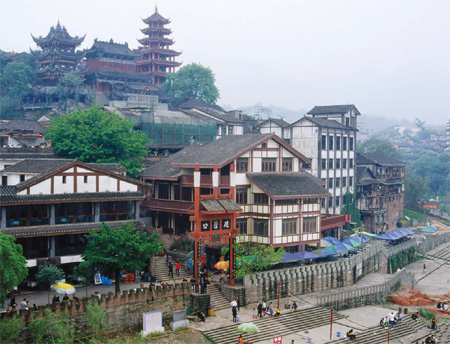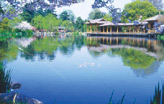Some like it hot
Updated: 2011-03-04 10:18
By Hu Haiyan (China Daily European Weekly)
 |
|
Chongqing is surrounded by mountains on all sides and is |
Visitors to 'mountain city' come for the spicy food and spectacular scenery
Chongqing is a 3,000 year-old city with a population of more than 32 million, making it the largest municipality not only in China but also in the world. The city was once part of Sichuan province, in 1997, it became one of China's four municipalities (the other being Beijing, Shanghai and Tianjin) directly administered by the central government.
Located in southwestern China at the juncture of the Yangtze River and Jialing rivers, it is famous for its hot and spicy food and mountainous terrain.
Chongqing is surrounded by mountains on all sides and also by the Changjiang and Jialing rivers on three sides and is called the "mountain city".
The streets are staggered, one above the other, on the sloping hills, which overlook the river.
 |
At night, house lights shine across these rolling hills and sparkle like stars.
The city's bridges also come alight at night and ships cruising along the two rivers fly like sparks.
The unique land formation has a bearing on the weather. The city has a humid, cloudly climate with an annual mean temperature of 18.6 C.
The rainy season is long but there is very little snow and frost. Mist lingers in spring and autumn, hence another nickname, "Misty Chongqing".
The splendid scenery of this famous mountain city attracts millions of tourists each year.
One of the highlights is the Dazu Stone Carvings, which are one of China's World Cultural Heritage sites. Here are five popular spots worth visiting.
1. Ciqikou
Situated on the banks of the Jialing River, not far from its confluence with the mighty Yangtze, is the ancient village of Ciqikou. Covering an area of some 1.2 square kilometres it is 14 km west of Chongqing.
The history of Ciqikou can be traced back more than 1,700 years and gets its name after all the classic porcelain handicrafts made in the village.
When visiting Ciqikou, travelers will find that the locals are dedicated to their traditional way of life and are unaffected by the modern influences found in the larger towns and cities.
The three notable attractions of the village are the teahouses, the artists' studios and the Shu Embroidery workshops.
In 1998, the State Council listed Ci Qi Kou as a protected cultural site.
2. People's Assembly Hall
In 1951, under the leadership of Marshal He Long, an auditorium was planned to accommodate domestic and overseas guests. Completed in 1954, it was named the Chongqing People's Assembly Hall.
After half a century, it still stands prominently at Xuetian Wan, Renmin Road and is one of the landmark buildings in the city. This is one of the largest public assembly buildings in China which, though built in modern times, emulates traditional architectural styles.
The hall complex is a cluster of attached structures, which contain the hall and three attached buildings to the east, south and north. At first glance, the People's Assembly Hall looks a little like the Temple of Heaven in Beijing.
It is spanned by a greenish glazed tile dome, which is supported by scarlet columns. The dome, its parapet railing and brim all gleam under the sun giving it a sense of granduer.
The building's pillars and other structural elements are sculpted ornately and the entire assemblage is nestled around lush trees.
3. Nanshan Park (Nanshan Scenic Area)
Nanshan Park is located in the southeast part of the city and consists of three distinct parts: Nanshan, Santai'an Hill and the Sports Stadium. It is surrounded by the Nanshan scenic mountain area, and has an elevation of 681 meters.
The park features various kinds of trees and flowers, and in spring, beautiful flowers bloom everywhere, their pleasant scent filling the air.
In summer, azaleas and white orchids flourish while in the golden autumn chrysanthemums blossom and the osmanthus spreads its sweet scent. Then after the cold winter, plums blossom.
4. Chaotianmen
Chaotianmen is situated at the confluence of Jialing and Yangtze rivers and together with nearby Chaotianmen Square is the best place to overlook the two scenic rivers.
During the Ming Dynasty (1368-1644), Dai Ding, the director of Chongqing at that time, built 17 magnificent gates. The largest gate is Chaotianmen and four big Chinese characters, "Gu Yu Xiong Guan (the Impregnable Pass of Ancient Yu)", are inscribed on it.
In summer or autumn, visitors can clearly see the dividing line between green Jialing River and yellow Yangtze River, the golden waterways of China.
5. Dazu Rock Carvings
Dazu county is 'the county of rock carving' and is located 167 km east of Chongqing. Visitors can take a bus at the Caiyuan Ba, Chongqing to the Dazu county bus station.
The Dazu Rock Carvings area contains all the cliff-side carvings in Dazu county. The collection is composed of rock carvings in Beishan, Baodingshan, Nanshan, Shimenshan as well as Shizhuanshan, all of which demonstrate the most exquisite skills.
The Dazu Rock Carvings started around 650 during the Tang Dynasty (AD 618-907) and continued through the Ming Dynasty and the Qing Dynasty (1616-1911). Today, they are as famous as the Mogao Caves in Dunhuang, Gansu province.
E-paper

City of Joy
Welcome to the 'world of smiles' where life meanders slowly.
Debate on nuclear power revived
The future is now
Common approach
Specials

Beloved polar bear died
Berlin's beloved polar bear Knut, an international star died Saturday.

Panic buying of salt
Worried Chinese shoppers stripped stores of salt on radiation fears.

'Super moon'
The "Super Moon" arrives at its closest point to the Earth in 2011.
